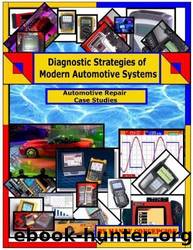Automotive Repair Case Studies (Diagnostic Strategies of Modern Automotive Systems Book 9) by Concepcion Mandy

Author:Concepcion, Mandy
Language: eng
Format: epub
Publisher: www.autodiagnosticsandpublishing.com
Published: 2011-06-19T04:00:00+00:00
Fig 2 – CAM & CRK sensor relationship. The two signals are out of synchronization. This pointed to a possible jumped timing belt.
Fig 3 – Broken key in the timing belt sprocket.
The Distributor Reference signal coming from the ignition module had good amplitude and was not braking up. This signal is the synthesized CRK sensor signal coming from the ignition module. At the same time, we can see that after start-up the EST signal is also good. The By-Pass signal at the bottom of Fig 1 is the switchover by the ECM to computer controlled timing. In most GM ignition systems, after the engine reaches over 400 RPM the ECM takes ignition control from the ignition module. The ECM does this by switching the By-Pass line high. All of the ignition signals were in proper order. So the problem was definitely not an ignition-related fault. But what else could cause the backfire condition and the no start?
The next thing I did was to make a quick scanner PID diagnostic, while cranking the engine. All the PIDs seemed fine with one exception. The MAP sensor was not registering correctly. I had seen enough cranking MAP readings to know that a cranking engine should have at least 5 ’ Hg of vacuum, which would give me a reading of around 3.00 volts or so. This wasn’t the case.
****
Download
This site does not store any files on its server. We only index and link to content provided by other sites. Please contact the content providers to delete copyright contents if any and email us, we'll remove relevant links or contents immediately.
| Automotive | Engineering |
| Transportation |
Urban Outlaw by Magnus Walker(2950)
Never by Ken Follett(2880)
OPNsense Beginner to Professional by Julio Cesar Bueno de Camargo(2803)
Sapiens and Homo Deus by Yuval Noah Harari(2414)
Machine Learning at Scale with H2O by Gregory Keys | David Whiting(2291)
A Short History of Nearly Everything by Bryson Bill(2135)
Will by Will Smith(2042)
Hooked: A Dark, Contemporary Romance (Never After Series) by Emily McIntire(1959)
Borders by unknow(1785)
Rationality by Steven Pinker(1765)
Holy Bible (NIV) by Zondervan(1716)
Freedom by Sonny Barger(1485)
The One Percenter Encyclopedia by Bill Hayes(1463)
Five Ways to Fall by K.A. Tucker(1397)
Girls Auto Clinic Glove Box Guide by Patrice Banks(1362)
Far and Near by Neil Peart(1356)
The Becoming by Nora Roberts(1330)
Cuba's Car Culture by Tom Cotter(1325)
A Short History of War by Jeremy Black(1300)
